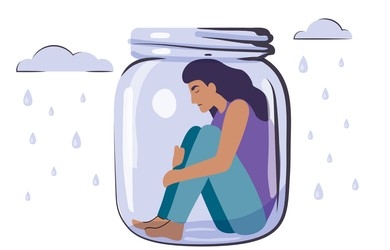How to Know if You Have Social Anxiety or Avoidant Personality Disorder?
Author : Dr Tulika | 30 Jul 2024
It's not uncommon for medical and behavioral health conditions to present with overlapping symptoms, leading to potential misdiagnoses. While some cases might only result in minor confusion, others—such as avoidant personality disorder and social anxiety disorder—can significantly impede effective treatment.

When these conditions are misunderstood or inaccurately diagnosed, it can prevent individuals from receiving the appropriate care they need, potentially allowing serious underlying issues to remain unaddressed.
Though both conditions manifest as intense fears of social interactions, they diverge in their roots and ramifications. Let’s delve into the nuanced distinctions and shared characteristics of these emotional landscapes to better understand and address them.
Understanding Social Anxiety Disorder
Social anxiety disorder, often referred to as social phobia, is more than mere shyness. It’s a profound, irrational fear of social interactions that can make everyday activities daunting. Imagine the trepidation of a performer about to step onto stage—this is the level of anxiety experienced by those with social anxiety disorder when faced with social situations.
Core Features: Social anxiety disorder is characterized by an intense fear of being judged or embarrassed in specific social scenarios. This fear can extend to various settings, such as attending parties, public speaking, or even eating out. The anxiety can manifest physically through symptoms like blushing, dizziness, and sweating, and behaviorally through avoidance of these triggering situations.
Symptoms Include:
- Emotional Symptoms: Persistent fear of embarrassment or rejection, heightened self-consciousness, and concern over others' perceptions.
- Physical Symptoms: Blushing, nausea, dizziness, rapid heartbeat, and sweating.
- Behavioral Symptoms: Difficulty maintaining eye contact, avoidance of social gatherings, and sometimes reliance on substances to cope with anxiety.
Social anxiety often emerges in late childhood or adolescence and can persist into adulthood if untreated. While individuals with social anxiety might avoid certain social situations, they generally still desire connection and engagement.

Avoidant Personality Disorder
Avoidant Personality Disorder (AVPD) is distinct from social anxiety disorder, though they share similarities. AVPD is a personality disorder characterized by pervasive feelings of inadequacy, hypersensitivity to criticism, and an intense fear of rejection. Unlike social anxiety, which may focus on specific situations, AVPD involves a broader spectrum of avoidance and deep-seated emotional issues.
Core Features: People with AVPD experience profound feelings of inadequacy and are extremely sensitive to criticism. They avoid not only certain social situations but also relationships in general due to their fear of rejection. This pervasive sense of inadequacy and desire for deep connections create a challenging dynamic, as their fear often leads to significant isolation.
Symptoms Include:
- Social Inhibition: A tendency to hold back in social situations due to fear of criticism or embarrassment.
- Intense Fear of Rejection: This fear extends to avoiding relationships entirely to prevent potential hurt.
- Low Self-Esteem: Feelings of inadequacy that go beyond typical social anxiety and deeply affect self-perception.
AVPD often develops in early adulthood, with childhood experiences such as neglect playing a role. The disorder results in significant difficulties in forming and maintaining relationships, exacerbating feelings of loneliness.
Comparing the Two: Overlap and Divergence
Social anxiety and AVPD share common themes, such as intense social discomfort and avoidance behaviors. However, their differences lie in their scope and impact:
- Scope of Fear: Social anxiety is typically specific to certain situations like public speaking or social gatherings, while AVPD involves a broader, more pervasive fear affecting most social interactions and relationships.
- Self-Perception: Social anxiety often involves a fear of judgment in specific scenarios but does not necessarily encompass a general sense of inadequacy. In contrast, AVPD is characterized by a deep-seated belief in one’s own inadequacy and pervasive feelings of rejection.
- Avoidance Behaviors: Individuals with social anxiety might avoid particular situations, while those with AVPD tend to avoid relationships and social interactions more broadly to protect themselves from perceived rejection and criticism.
Treatment Pathways
For Social Anxiety Disorder: Treatment often includes Cognitive Behavioral Therapy (CBT), which focuses on challenging and altering unhelpful thought patterns. Exposure therapy is also beneficial, gradually exposing individuals to feared social situations to build confidence and reduce avoidance behaviors. Medications such as antidepressants and anti-anxiety medications can also play a role.
For Avoidant Personality Disorder: Treatment for AVPD may involve CBT and exposure therapy, similar to social anxiety, but often includes psychodynamic therapy. This approach explores deep-rooted issues from past experiences and unconscious influences impacting current behavior. While there are no FDA-approved medications specifically for AVPD, treatments for co-occurring conditions can improve overall well-being.
The Road to Diagnosis and Healing
Determining whether one is affected by social anxiety disorder, avoidant personality disorder, or both requires a thorough evaluation by a qualified mental health professional. Diagnosis involves assessing symptoms, personal history, and familial patterns. Understanding these conditions’ distinct and overlapping features allows for tailored treatments that can significantly improve quality of life and social functioning.
If you or someone you know is struggling with these disorders, seeking guidance from a mental health professional can provide clarity and pave the way for effective treatment. The journey toward overcoming social anxiety and avoidant personality disorder, while intricate, holds promise for a richer, more connected life.




